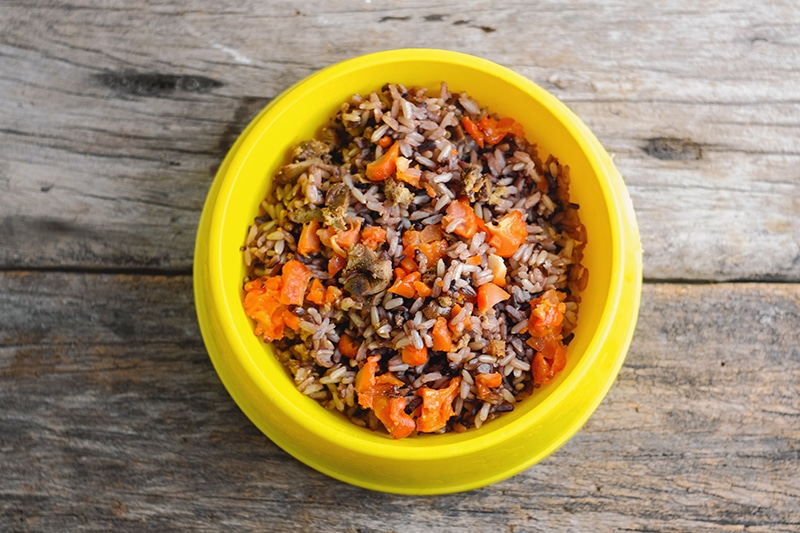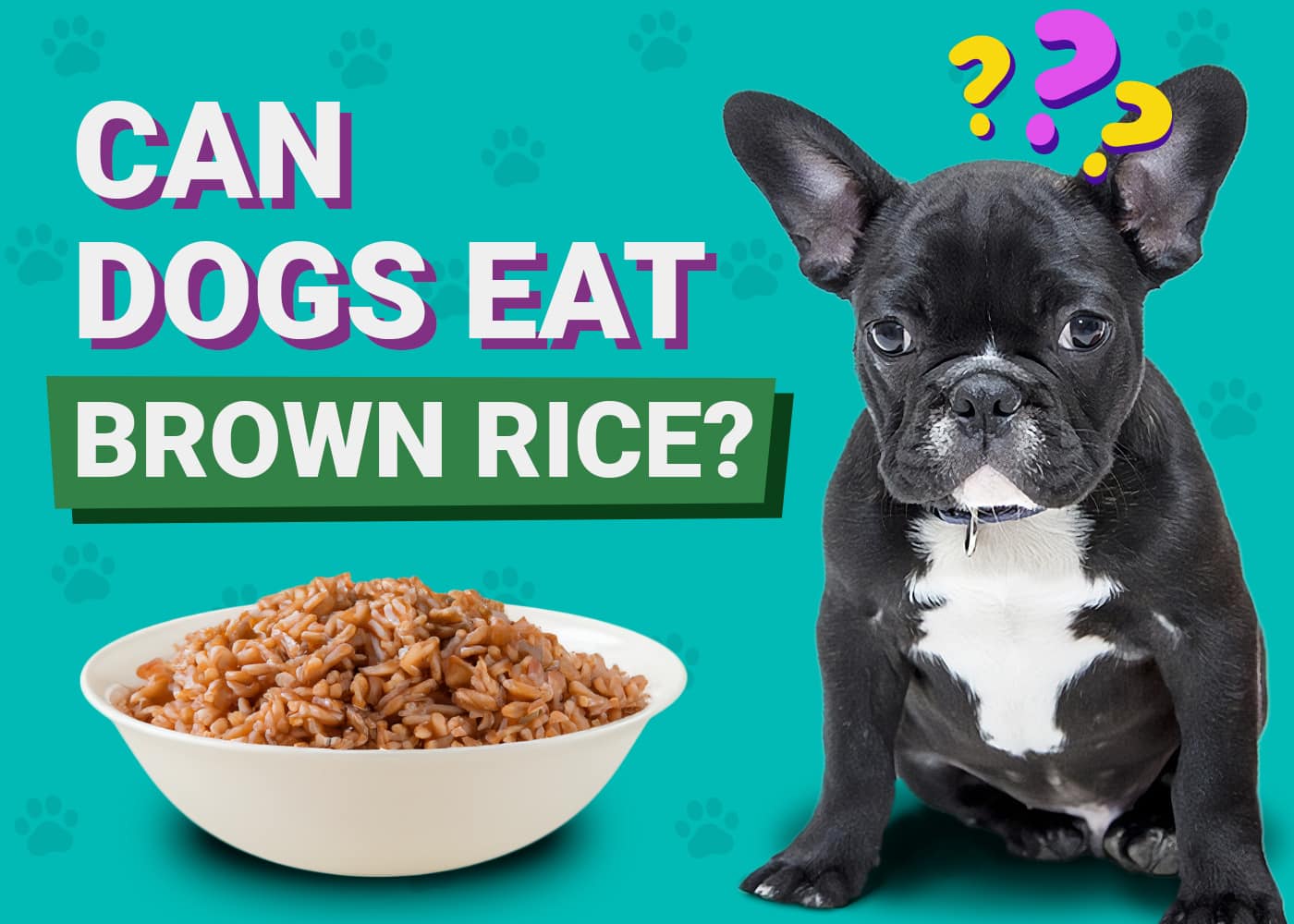Click to Skip Ahead
Brown rice is an excellent carbohydrate to include in your dog’s diet. It is seen as one of the more nutritious types of rice that is safe for your canine companion while being easy to digest.
Many households have white or brown rice in the pantry, and in most cases, it is a better option than white rice. This is due to the better nutrition that brown rice has to offer dogs, and it can be a great food to incorporate into your dog’s diet for extra fiber.

Safety & Nutritional Value
Safety
It is safe to feed plain, cooked brown rice to your dog. Not only is brown rice safe for your dog, but it is an ingredient found in many commercial dog foods. However, you should always double-check with your dog’s veterinarian before introducing new “people” foods into their diet.
Both puppies and adult dogs can eat brown rice, but you should ensure that the portion size is correct for your dog’s weight and that your dog has no potential allergies to brown rice.
PangoVet. It’s an online service where you can <b>talk to a vet online</b> and get the personalized advice you need for your pet — all at an affordable price!
</p>
<div class="su-button-center"><a href=https://www.dogster.com/dog-nutrition/"https://pangovet.com/?utm_source=dogster&utm_medium=article&utm_campaign=dog_eat_drink%22 class="su-button su-button-style-default" style="color:#FFFFFF;background-color:#FF6600;border-color:#cc5200;border-radius:9px;-moz-border-radius:9px;-webkit-border-radius:9px" target="_blank" rel="nofollow"><span style="color:#FFFFFF;padding:0px 24px;font-size:18px;line-height:36px;border-color:#ff944d;border-radius:9px;-moz-border-radius:9px;-webkit-border-radius:9px;text-shadow:none;-moz-text-shadow:none;-webkit-text-shadow:none"> Click to Speak With a Vet</span></a></div></div></div>"}" data-sheets-userformat="{"2":513,"3":{"1":0},"12":0}"> If you need to speak with a vet but can’t get to one, head over to PangoVet. It’s an online service where you can talk to a vet online and get the personalized advice you need for your pet — all at an affordable price!

Nutritional Value
Dogs are often described as facultative carnivores or omnivores, meaning they can eat both animal protein and plant-based ingredients in their diet. Dogs can benefit from the dietary fiber that brown rice has to offer your dog, which is around 0.12 ounces of fiber per serving cup.
In comparison to white rice, brown rice has more fiber and a lower glycemic index than white rice. White rice is typically fed to dogs who are suffering from an upset stomach and suffering from diarrhea or vomiting. This is because white rice is blander and easier to digest.
Brown rice contains vitamins and minerals that are good for dogs. This includes iron, vitamin B6, potassium, magnesium, and calcium. Brown rice is also a good source of plant-based proteins that might be useful for your dog. This carbohydrate-rich food is high in insoluble fiber, which can improve your dog’s gut health and help with bowel movements.
If it is suggested by your dog’s veterinarian, brown rice can be given to dogs who have mild constipation. The high amount of insoluble fiber in brown rice can help relieve mild constipation. This is because the insoluble fiber from brown rice can pass through your dog’s digestive tract without being digested.

Is Brown Rice Healthy for Dogs?
So, why should you feed brown rice to your dog and is it healthy? While dogs don’t necessarily need brown rice in their diet, some dogs may benefit from the additional insoluble fiber.
Your dog should be getting most of their nutrients from their staple food if it is balanced, so adding brown rice into your dog’s diet is not usually to increase its vitamin and mineral intake. Instead, most people feed brown rice to their dogs as a healthy way to increase their dog’s fiber intake.
- High in insoluble fiber
- Helps improve gut health
- May help relieve constipation
- Rich in iron and vitamin B
- Less processed than white rice
- Higher nutritional value than white rice
- Helps bind the stool during bouts of diarrhea
- A source of dietary fiber
Feeding Brown Rice to Dogs
If you plan to feed your dog brown rice, it should be fed occasionally alongside your dog’s daily diet unless your dog’s veterinarian advises you to feed it more often. You should first ensure that your dog has no adverse health effects since they have begun eating brown rice. If you notice any hair loss, excessive itching, reoccurring ear infections, or dry skin after your dog starts eating brown rice, it could be an allergic reaction.
When preparing brown rice for your dog, it should be cooked and plain. Avoid using any seasonings and sauces that would make the rice taste better for you. Dogs don’t need any of these seasonings, and some might be harmful to your dog. The brown rice should be boiled in water until thoroughly cooked, and you do not need to add any salt.

How Much Brown Rice Can Dogs Eat?
Your dog’s veterinarian can give you guidance on how much brown rice your dog needs according to their weight. A general amount of rice to feed to a dog is between ¼ of a cup to ½ cup of brown rice depending on your dog’s breed.
The amount of brown rice may vary if you are feeding it as part of a bland diet if your dog has an upset stomach.

Conclusion
It is safe for dogs to eat plain brown rice that has been properly cooked. You can also find brown rice as an ingredient in many dog foods. In comparison to white rice, brown rice has a lower glycemic content, and it is considered to be more nutritious. The insoluble fiber found in brown rice can help dogs with mild diarrhea since it has binding properties while helping move things along in your dog’s digestive tract.
When fed as part of your dog’s staple diet with guidance from your dog’s veterinarian, brown rice can be a tasty supplemental food for many dogs.
Related Read:
- Can Dogs Eat Jasmine Rice? Vet Reviewed Facts & Tips
- Can Dogs Eat Rice Pudding? Vet Approved Facts & FAQ
Featured Image Credit: Polina Tankilevitch, Pexels











